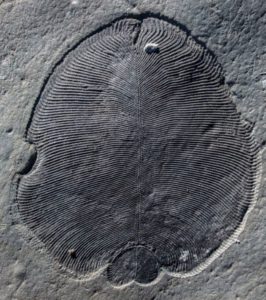Sep 24 2018
Oldest Animal Identified
 Beginning 542 million years ago there was what scientists call the Cambrian Explosion. The name may be a bit misleading, because it is only an explosion in geological terms, taking tens of millions of years. This event refers to the geologically rapid appearance of many different phyla of multi-cellular creatures. All modern phyla (the taxonomic level just below kingdom) are represented in the Cambrian, along with many that did not survive to modern times.
Beginning 542 million years ago there was what scientists call the Cambrian Explosion. The name may be a bit misleading, because it is only an explosion in geological terms, taking tens of millions of years. This event refers to the geologically rapid appearance of many different phyla of multi-cellular creatures. All modern phyla (the taxonomic level just below kingdom) are represented in the Cambrian, along with many that did not survive to modern times.
The idea is that once multicellular life appeared, this new strategy was wildly evolutionarily successful, undergoing extreme adaptive radiation. Further, multicellular life evolved hard parts, like shells and bones, that fossilize well. The fossil record essentially turns on at this point, creating the impression of a rapid appearance of many species. However, there are fossils of older living organisms without hard parts, but they are more rare, requiring special conditions for their preservation.
One such pre-Cambrian group is called the Ediacaran fauna, from 571 to 541 million years ago. These are mostly large flat creatures, as if multicellular life had not yet worked out the trick of three-dimensionality. Getting oxygen to deep tissues requires specialized structures, not necessary for a flat organism. Scientists, however, did not know what the Ediacaran fauna were. Were they mats of fungi, or a failed dead-end branch of life wiped out the the more advanced three-dimensional Cambrian fauna? And if either of these two possibilities were true, then were are the precursors to the Ediacaran fauna? Their absence is not shocking, given that they would have been entirely soft creatures, but still, it would be nice to find some evidence of the lead up to the Cambrian.
A nice solution would be if the Ediacaran fauna were the precursors of the Cambrian fauna – that would solve two mysteries in one. The fossil record, however, does not yet have the resolution in this time period to make a direct morphological connection.
Now it appears that scientists may have solved the puzzle with an exquisitely preserved Ediacaran specimen – a species known as Dickinsonia (the picture above). This is a large, flat, oval creature with many apparent folds. The authors write:
Here, we show that lipid biomarkers extracted from organically preserved Ediacaran macrofossils unambiguously clarify their phylogeny. Dickinsonia and its relatives solely produced cholesteroids, a hallmark of animals. Our results make these iconic members of the Ediacara biota the oldest confirmed macroscopic animals in the rock record, indicating that the appearance of the Ediacara biota was indeed a prelude to the Cambrian explosion of animal life.
They found organic cholesterol molecules in the fossil at a density of up to 93%, and only 11% in surrounding sediments. Animals make cholesterol, and they are the only kingdom to do so, so the authors conclude that Dickinsonia was an animal (making it the oldest confirmed animal in the fossil record).
While this may be the most straightforward interpretation, the way I see it there are three possibilities here. The first is that Dickinsonia and later animals share the trait of producing cholesterol because they inherited this trait from a common ancestor. In this case Dickinsonia and its relatives may be ancestors to Cambrian animals (possibility one) or they may be a side branch splitting off after this common ancestor (possibility two). This second hypothesis means there are other undiscovered creatures that are ancestors to the Cambrian fauna during the Ediacaran period.
The third possibility is that the Ediacaran fauna represent a distinct kingdom of life that happened to independently evolve the ability to make cholesterol. This would put them as a separate independent evolution of multicellularity – a dead end that did not leave any descendants, and were essentially replaced by the more adaptive Cambrian fauna. This is a matter of whether the cholesterol marker is homologous (derived from a shared ancestor) or analogous (independently evolved). So far as we know cholesterol is an unambiguous marker of the animal kingdom. But I don’t know how you can apply this to an unknown group, such as the Ediacaran fauna. In the summary, the authors are a bit more conservative, saying that “the Ediacaran biota may have been a precursor to the explosion of animal forms later observed in the Cambrian.” It seems like the “may” is more appropriate here.
But it seems clear that the presence of cholesterol in Dickinsonia strongly suggests that it, and therefore other similar Ediacaran fauna, were animals. This further makes them the only known candidate for ancestors to Cambrian fauna. In reality, my possibilities one and two are really a false dichotomy. It is always true that specific specimens are very unlikely to be direct ancestors to later groups. The real question is a matter of degree – how closely related are they to the direct ancestors? If they are close enough, then we consider them on the main path to the later groups. If they are distant enough, they are a “side branch.” But there is a continuum in between.
Because there are various ways to interpret the data, that is why scientists need multiple independent lines of evidence, so they can triangulate to the best answer. It will be interesting to see how the scientific community reacts to this evidence, and what consensus emerges. Then we will have to wait until further evidence comes to light, and advances the consensus by one more step. Eventually a clear picture will emerge.






